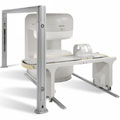 | Info
Sheets |
| | | | | | | | | | | | | | | | | | | | | | | | |
 | Out-
side |
| | | | |
|
| | | | | |  | Searchterm 't1' was also found in the following services: | | | | |
|  |  |
| |
|
When a multi shot technique is applied, each shot will have its own effect on the prepulse, with a scan time increase. Multiple shots allow a shorter IR delay but at the cost of increased scan time.
In multi shot technique (also called mosaic imaging), a group of samples, which are contiguous in k space are acquired in the same sequence repetition. The phase encoding steps or profiles are split into 'shots' (sub-acquisitions). The shot interval is the time between the shots. Usually kept as short as possible. Because the acquisitions are divided into different shots, each shot will have less T1 variation, thereby increasing T1 contrast. Two excitations, each requiring the data for one half of k-space, are the simplest variation of multi shot techniques (e.g. positive versus negative phase encoding).
The alternative to this mosaic strategy for multi shot EPI is interleaving. In interleaved sequences, each repetition acquires every nth (n is the number of shots) line in k-space and for the complete raw data set the various repetition data are interlaced.
See also Single Shot Technique. | |  | | | |
|  | |  |  |  |
| |
|

From Philips Medical Systems;
the Panorama 0.23 T, providing a new design optimized for patient comfort, faster reconstruction time than before (300 images/second) and new gradient
specifications. Philips' Panorama 0.23 T I/T supports MR-guided interventions, resulting in minimally invasive procedures, more targeted surgery, reduced recovery time and shorter hospital stays. Optional OptoGuide functionality enables real-time needle tracking. Philips' Panorama 0.23 TPanorama 0.2 R/T is the first and only open MRI system to enable radiation therapy planning using MR data sets. The Panorama also features the new and consistent Philips User Interface, an essential element of the Vequion clinical IT family of products and services.
Device Information and Specification CLINICAL APPLICATION Whole body SE, FE, IR, FFE, DEFFE, DESE, TSE, DETSE, Single shot SE, DRIVE, Balanced FFE, MRCP, Fluid Attenuated Inversion Recovery, Turbo FLAIR, IR-TSE, T1-STIR TSE, T2-STIR TSE, Diffusion Imaging, 3D SE, 3D FFE, MTC;; Angiography: CE-ANGIO, MRA 2D, 3D TOFOpen x 46 cm x infinite (side-first patient entry) POWER REQUIREMENTS 400/480 V COOLING SYSTEM TYPE Closed loop chilled water ( chiller included) | |  | |
• View the DATABASE results for 'Panorama 0.23T™' (2).
| | | | |  Further Reading: Further Reading: | News & More:
|
|
| |
|  | |  |  |  |
| |
|
Quick Overview
DESCRIPTION
Signal loss, intensity variations

Image Guidance
| |  | | | |
|  |  | Searchterm 't1' was also found in the following services: | | | | |
|  |  |
| |
|
| |  | |
• View the DATABASE results for 'R1' (33).
| | | | |
|  | |  |  |  |
| |
|
Reciprocals of the relaxation times, T1 and T2 ( R1 = 1/ T1 and R2 = 1/T2). There is often a linear relation between the concentration of MR contrast agents and the resulting change in relaxation rate.
The rate of relaxation is influenced by molecules with protons that are tumbling. A slower tumble rate will result in faster relaxation rate (shorter relaxation time). Due to the molecular structure of fat with its larger size than water, fat will tumble slower than water molecules. The slower tumble rate of fat enables a faster relaxation rate. | |  | |
• View the DATABASE results for 'Relaxation Rates' (5).
| | | | |  Further Reading: Further Reading: | | Basics:
|
|
News & More:
| |
| |
|  | |  |  |
|  | | |
|
| |
 | Look
Ups |
| |